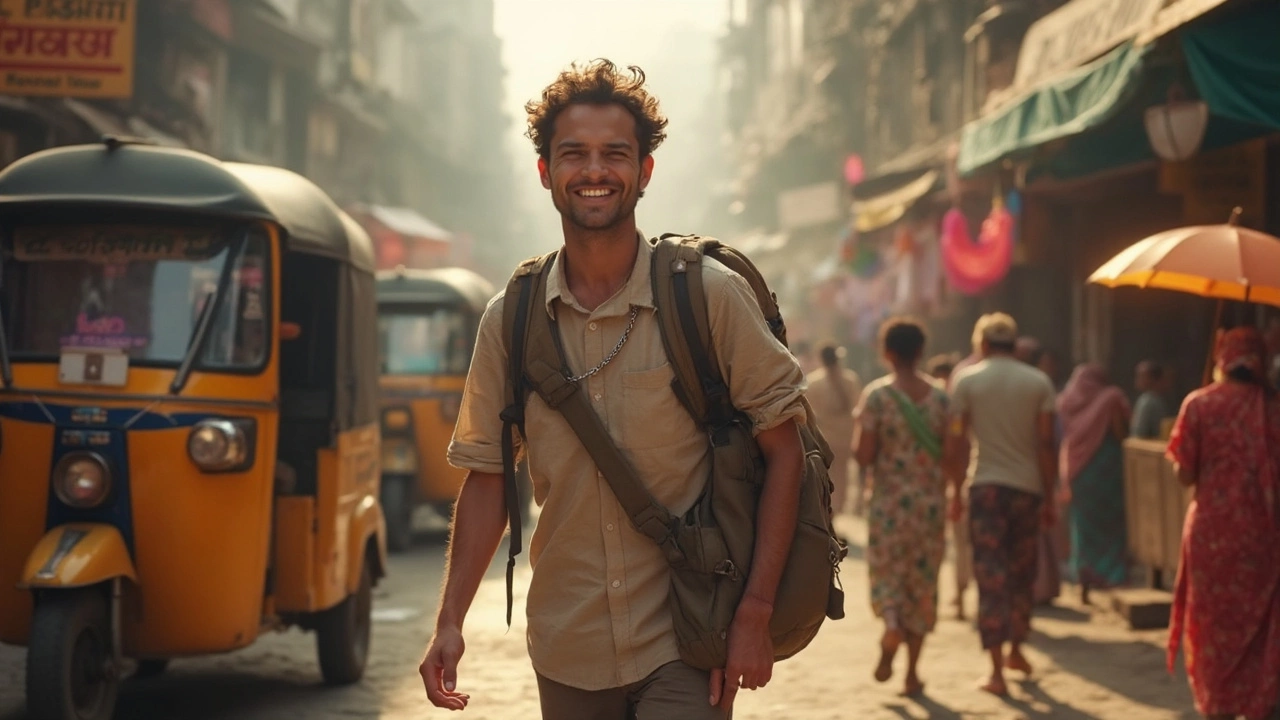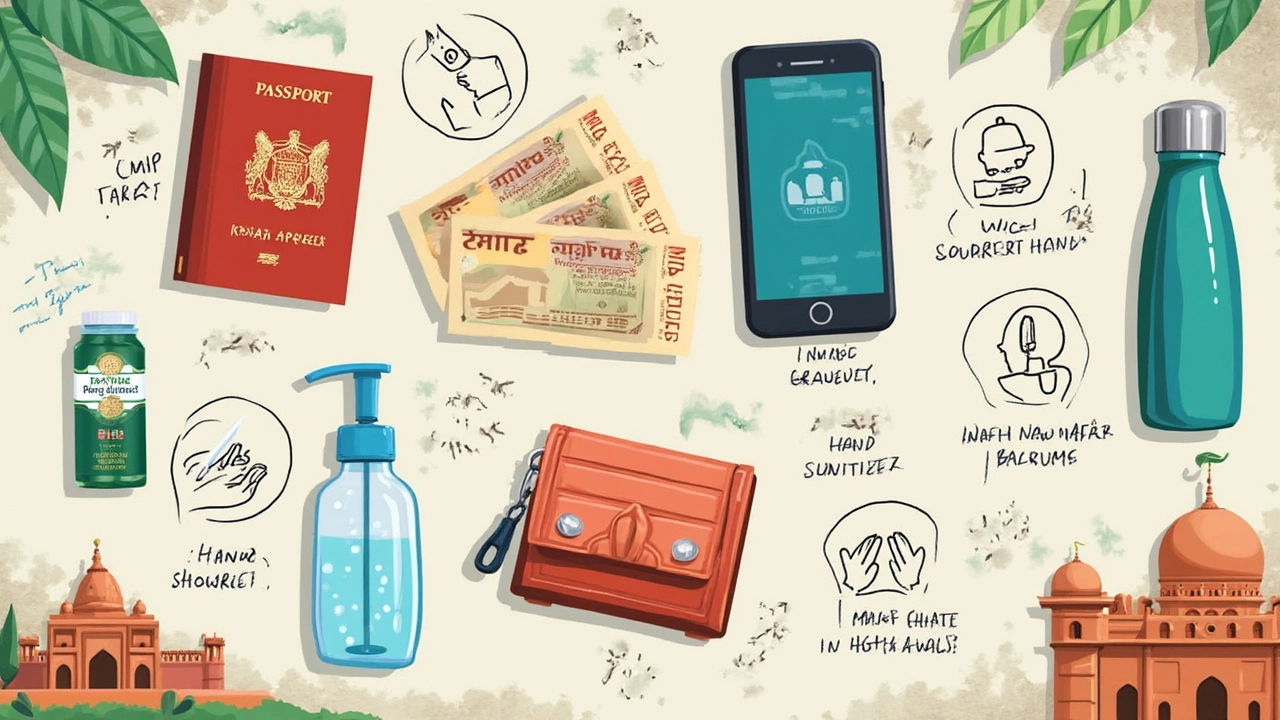Is it Safe for a US Citizen to Travel to India? Budget Travel Advice You Can't Miss
 Jun, 7 2025
Jun, 7 2025
You hear wild stories about India—some good, some not so good. But is it actually safe to go there as an American, especially if you want to travel cheap? The honest answer: yes, with a bit of street smarts and the right info, you’ll probably be fine. India’s chaos can be a shock, but millions of foreigners visit every year and have an eye-opening (and affordable) adventure.
Let’s get practical. Most parts of India are no more risky than big cities back home—just different. Petty theft, like bag snatching or pickpocketing, is more common than anything extreme. Think crowded trains or busy markets in Delhi, Mumbai, or Kolkata. Don’t flash wads of cash or leave your phone on a cafe table, and you’re handling half the risk already. At night, stick to busy, well-lit areas, and if you’re taking a cab or tuk-tuk, go with an official app or trusted ride—Uber and Ola are everywhere in big cities.
- What's the Real Situation? India Safety for US Citizens Right Now
- Navigating Indian Cities and Local Transport on a Budget
- How to Stay Healthy and Avoid Common Pitfalls
- Smart Money: Saving and Spending Wisely While Traveling India
What's the Real Situation? India Safety for US Citizens Right Now
If you’re looking up "India travel safety", you probably want facts, not hype. Right now, the U.S. Department of State ranks India as Level 2: "Exercise Increased Caution." That’s the same as countries like France or the UK. We're not talking no-go zones, but you do need to use common sense. Keep an eye out for petty theft and be careful in crowded places, just like you would at Times Square or LA’s Metro.
Certain spots along the border with Pakistan or Northeast India are flagged for higher risks. But honestly, if you're visiting main cities like Delhi, Mumbai, Bangalore, Goa, or even big tourist sites like the Taj Mahal, you’re not wandering into conflict zones. Rural areas are generally calm, though the roads can be a different kind of adventure.
The big cities have a heavy police presence around tourist hubs. You’ll also see more CCTV cameras in public spaces since late 2023, which ramped up after a few headline incidents. Here’s the vibe from the State Department:
“Violent crime is rare for foreigners in Indian tourist areas, but theft, scams, and harassment are more common. Travelers should remain alert in crowded places, especially transit hubs.”
Women travelers face extra challenges—solo female travel is rising in India, but catcalling or unwanted attention can happen, especially at night or in less touristy towns. For everyone, scam artists work overtime in touristy areas. Classic tricks include fake tour guides and overpriced taxis. Stick to prepaid or official providers—it’s easy with ride apps now.
- If you need help, most city police stations have separate tourist desks now. Look for the blue Tourist Police signs in major cities and at big monuments.
- Check local embassy safety updates before and during your trip—they can be life savers if protests, extreme weather, or transportation strikes pop up.
- Keep copies of your passport and visa, both digital and printed. If your stuff vanishes, that’ll sort you out fast with local authorities.
So, what’s the bottom line? India isn’t risk-free, but it’s not a danger zone either if you pay attention. Smarter choices mean smoother, safer travels.
Navigating Indian Cities and Local Transport on a Budget
Figuring out how to get around India without blowing your wallet can seem like a puzzle. Good news: local transport in India is cheap, and it’s built for daily life—if you know how to use it right.
Trains are the backbone here. For longer city-to-city trips, nothing beats the Indian Railways. There’s an app—IRCTC Rail Connect—where you can book seats, but booking early is key for popular routes. Sleeper class is budget-friendly and totally safe if you keep your stuff close. If you want a bit more comfort, spring for 3AC (air-conditioned). Trains fill up fast, especially during holidays, so jump on tickets as soon as you know your dates.
Inside cities, the scene changes fast. Big metro areas like Delhi, Mumbai, Bengaluru, Chennai, and Hyderabad have decent metro rail systems. They’re cheap, clean, and a favorite for daily commuters. Metro rides usually cost between 10 to 60 INR (that’s just a few cents up to under a buck).
| Transport Type | Typical Cost (USD) | Best For |
|---|---|---|
| Metro (Delhi, Mumbai, etc.) | 0.12 - 0.80 | Quick city commutes |
| Auto Rickshaw (Tuk-tuk) | 0.50 - 5.00 (short ride) | Flexible, door-to-door |
| Ola/Uber (city ride) | 1.50 - 10.00 | Comfort and English app access |
| City Bus | 0.10 - 1.00 | Super cheap, but crowded |
| Train (Sleeper class intercity) | 3.00 - 10.00 (100-500 miles) | Longer distance travel |
Auto rickshaws—or tuk-tuks—are everywhere and great for short trips. Always ask for the meter or agree on a price first. If you look like a foreigner, they might start high. Bargain down, and don’t be shy—it’s expected. Locals usually pay a third to half the first price you hear. For less hassle, ride apps like Uber and Ola are a lifesaver. Both work with international credit cards and let you see your driver’s info, route, and cost upfront.
Local buses are a must for extreme budget travelers. They go everywhere but get crowded and sometimes lack English signs. Use Google Maps transit mode—it actually works pretty reliably for major cities. Some spots have women-only metro coaches or bus sections; follow the signs if it applies to you or your group.
Here are a couple hell-no’s: avoid sketchy unofficial taxis at train stations or airports. Stick with prepaid booths or app cabs—way less stress. Night buses or trains can be fine, but lock your bag and keep valuables on you, not in overhead racks. Trust your gut—if a ride feels off, bail early.
If you’re in a less touristy area with no ride apps, download offline maps. Ask hotel staff or shopkeepers for going rates—they’ll usually give you a real answer. And a little patience helps: India's traffic jams and busy stations move at their own pace. But when you master the system, you get to see so much more for so much less. India travel safety has a lot to do with simply being aware and blending in with locals on the move.

How to Stay Healthy and Avoid Common Pitfalls
No matter how tight your budget, staying healthy in India is doable—and way easier if you’re prepared. Indian street food is legendary, but a Delhi belly (as in, food poisoning) is no joke. The main thing is: always eat food that’s cooked fresh and served hot. Skip anything raw, like salads or cut fruit on the street, unless you peel it yourself. Water safety is a big one. Tap water just isn’t safe for travelers—grab bottled water with the seal intact, or better yet, carry a filtered water bottle.
Vaccines matter too. The CDC recommends shots for Hepatitis A, Typhoid, and routine stuff like Tetanus before heading to India. Mosquitoes can carry dengue or malaria, especially in the rainy months (June–September), so use a repellent with DEET and sleep under a net or in a room with AC or screens if possible.
Here's some key info for India travel safety at a glance:
| Health Concern | What to Do | Quick Tip |
|---|---|---|
| Contaminated water | Drink bottled or filtered only, no ice | Check seal on bottles; carry filter or iodine tablets |
| Street food | Choose busy stalls, eat cooked & hot | If locals line up, it’s probably safe |
| Mosquito bites | Use repellent, cover up, sleep screened or with net | Wear long sleeves after sunset |
| Getting sick (fever, stomach issues) | Carry basic meds, seek local medical help fast | Pharmacies everywhere—and cheap |
Scams can trip you up just as much as germs. Classic ones are overpriced cab fares, fake SIM cards, and bogus tour guides who try to steer you to their “cousin’s” shop. Book tickets and day trips with well-rated apps or through your hostel. Don’t share cash before service or agree to deals that sound too sweet. If you’re confused, ask someone who looks like a fellow traveler or head to the official tourist desk.
Western toilets aren’t standard in every place—you’ll run into squat toilets and need to bring your own TP. A small hand sanitizer bottle saves the day, too. If you take regular meds, pack enough for the whole trip and carry a prescription copy just in case.
It all boils down to being aware, not paranoid. Most locals want to help, not hustle you. Trust your gut, double-check what you eat and drink, and tackle each day with some common sense.
Smart Money: Saving and Spending Wisely While Traveling India
Traveling through India on a budget means you have to spend smart. Good news—you really can get by with not much. Even in 2025, a $1 USD is worth around 83 Indian Rupees, so your dollar can take you far. Hostels in major cities like Delhi or Bengaluru start at $6–8 a night, and delicious local meals can hit under $2 if you eat where locals eat.
For local transport, skip private cabs and jump on the metro or use buses. Cities like Delhi and Mumbai have pretty reliable metro systems. Auto-rickshaws are everywhere, but always insist on the meter or agree on the fare before hopping in. If you’re traveling between cities, India’s sleeper trains are legendary for a reason: they’re dirt cheap, surprisingly social, and safe if you keep an eye on your stuff.
Watch out for unnecessary fees at ATMs. Stick to bigger banks (like SBI or ICICI) and be mindful that international card charges can pile up. Better yet, bring a card made for travelers—ones with no foreign ATM fees can save you a bundle. For payments, cash is still king in small towns, so stash some for emergency. But digital wallets like Paytm or Google Pay work great in bigger cities and cut down on the hassle of carrying a fat wad of rupees.
Don’t get caught in tourist scams. Common tricks include overcharging on taxi rides, fake train ticket offices, or overpriced souvenirs—don’t be afraid to haggle, especially at local markets. If they see you’re a tourist, the first price is almost always double.
Here’s a quick snapshot of what you can expect to pay for basics in India in 2025:
| Item/Service | Average Cost in INR | USD Equivalent |
|---|---|---|
| Bottle of filtered water | 20 | ~$0.24 |
| Hostel dorm bed (metro city) | 600 | ~$7.20 |
| Local city bus ride | 15 | ~$0.18 |
| Metro ride (short distance) | 30 | ~$0.36 |
| Thali meal at local eatery | 150 | ~$1.80 |
Here are a few budget travel tips that work in real life:
- Book trains or buses early—last minute rates can spike, especially during festivals.
- Eat at busy places—if locals fill the spot, it’s usually cheap and safe.
- Pack a water filter bottle, so you don’t need to buy bottled water everywhere.
- Use budget travel India forums for updated tips and honest reviews from fellow travelers.
- Keep small bills handy for quick purchases—cashiers often "don’t have change."
Money goes further in smaller cities and rural areas, so don’t be afraid to get off the beaten path if you’re up for it. India’s chaos is real, but if you’re smart about your spending, it can also be one of the cheapest ways to see an insanely diverse country.